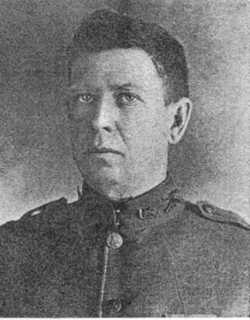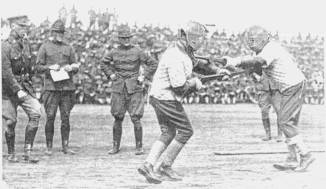
From Alice Palmer Henderson, The Ninety-First,
The First at Camp Lewis (Tacoma, Washington: John C. Barr, 1918), 306-309.
Readers with additional information are requested to contact the editor
at jrsvinth@juno.com.
Speaking of [U.S. Army Military] Intelligence, there is now attached to the Military Police a man who until Spring [1918] was Instructor of Jui-jitsu [sic] in the [91st] Divisional School of Intelligence, Capt. Risher Thornberry, the First and Only foreigner to obtain a diploma from the Japanese government for the practice of its national "Gentle Art of Self Control," which gentle art can cause instant death, if need press, with no other weapon than hands and body. [EN1] The Japanese samurai, nobility, could defile their swords upon no man not equal or superior. The Ninety-First was again most fortunate in securing a master of the difficult system, a man who was chosen to teach Jui-jitsu to the Japanese themselves. Curiously, and wisely, they will not issue a diploma to a student who has but proved himself proficient, he must teach others, for a set period, successfully. It is something, then, to be instructed by a man who holds that curious scroll. Capt. Thornberry published a series of illustrated books upon Jui-jitsu several years ago. [EN2]
"The principle of the system is simple, that of the lever," he explains. That may seem simple to him and clear to you, but to me there are still several points unillumined about this "wrestling kit which no soldier should be without."

Capt. Thornberry's life would furnish plots for plays, for books of travel, war, adventure, for mystery stories that would chain Conan Doyle to his desk -- that is, it would if he ever spoke. Von Moltke [a German hero of the Franco-Prussian War] was said to have been silent in seven languages; Thornberry has been silent in seventy crying adventures. Perhaps it's because he's a Quaker, from a family who came to this country in times of persecution for the peace and quiet denied them even there.
In the big still frame you can see immense strength, but no hint, nor in the almost expressionless face, of agility sudden as lightning. As for anything exciting, you would think his whole life presaged by his graduation from Hiram Medical College, Ohio. [EN3] He spent a few months in the Florida camps and went to Cuba during the Spanish-American war. He was a surgeon aboard the Hospital Ship Relief for two and a half years, went through the Boxer Rebellion and the Russo-Japanese war, entered the Y.M.C.A. work in 1902 at Nagasaki, having done naval work in the Philippines. [EN4] Nagasaki is the great coaling station of Japan. Here the Floating Society occupied the only clean [e.g., Temperate] building in the city and boasted the only soda water fountain in Japan, and "the fizz was twenty-five cents a glass." He was a U.S. marshal under Consul-General Fowler for a year.
[An obviously inflated story told by an unnamed "close friend" is deleted.]
He has lived in Mexico through all its revolutions since Madero. [EN5] Have you ever read "Real Soldiers of Fortune"? [EN6] One of them was Maj. [Frederick Russell] Burnham, hero of the Boer War, a relative of John Hays Hammond who put him in charge of his 600,000 acre concession in Sonora [Mexico]. There Capt. Thornberry and his little family lived for three years, and he was in entire charge of the protection of the Americans of the district and of their movement and rendezvous, should flight become advisable. This was from 1909 to 1912. [EN7] During this time he was closely associated with Maj. Burnham, one of the wonder scouts and intelligence men of the world. [EN8] Capt. Thornberry is invaluable to our service. His war record as surgeon was long, but he wished to go into the fighting Army, entered the Presidio, and was graduated from the First Training School as Captain. He now heads a company of Military Police and will go with them to France for another war. And a Quaker!
On pages 374-381, Henderson noted that prior to the 91st Division deploying to France, Captain Thornberry trained men to conduct reconnaissance in "No-Man's Land," a training site on Camp Lewis that was built to resemble a battlefield. Most of the training was in mapping, but some included training in "jui-jitsu."(Besides Thornberry, instructors included Corporal Lloyd Ireland, a postal clerk and "expert jui-jitsu-ist" from the Olympia, Washington, YMCA.) So officers could observe, soldiers conducting night training at this site simulated darkness by wearing dark goggles.

Gas and bayonet training was also conducted at "No-Man's Land." During the gas training, the American training chemical was chlorine. (Although the Germans used tearing agents such as CA and CN as early as 1915, the Allies did not use them until the postwar release of the relevant I.G. Farben patents.) There were no fatalities reported during training, so the masks and filters were obviously sufficient.
Bayonet training began with boxing lessons taught by the former professional boxer Willie Ritchie (real name: Gerhardt Steffens) and 472 assistants. ("Bayoneting is boxing with a gun in your hands," Ritchie was quoted as saying.) [EN9] Once boxing lessons were completed, then the soldiers advanced to bayonet courses set up at various sites around the camp; course supervisors included the British Lieutenant W. B. Warrell, the Canadian Sergeant L.F. Morris, and the University of Washington football star Cy Noble. [EN10] Henderson had this to say about Camp Lewis bayonet training (page 188):
… The officers insist that the men charge yelling, and some, before the attack, inflame their men with stories of Hun atrocities.
EN1. The "government recognition" implies Butokukai grading, but without knowing the name and affiliations of Thornberry's jujutsu instructor, this is purely speculation. Be that as it may, by 1918 two Britons (E. J. Harrison and W. E. Steers), one American (D. T. Weed), and a Russian (B. S. Oshchepkov) had all earned dan grades at the Kodokan.
EN2. There is no record of these books in the online catalog of the Library of Congress. But they probably did exist, as in 1958 the bibliography in Robert W. Smith's A Complete Guide to Judo attributed A General Course in Jiu-Jitsu. (California: American School of Jiu-Jitsu, 1933) and Twenty Lessons in Disarming a Holdup Man (Los Angeles: American School of Jiu-Jitsu, no date) to Thornberry. Smith also listed a third text whose author was probably Thornberry, namely Original and Exclusive Graphic Course of Instruction in Jiu-Jitsu (Los Angeles: American School of Jiu-Jitsu, 1934).
EN3. Thornberry attended Ohio’s Hiram College during the 1896-1897 academic year. College archives show his major as "Selected Studies." Although it did offer medical courses in 1896, Hiram College has been an undergraduate liberal arts institution since its founding in 1850, and was never "Hiram Medical College." E-mail from Joanne M. Sawyer, Archivist, Hiram College, April 3, 2000.
EN4. In 1898, the former passenger liner John English was refitted as the US Army Hospital Ship Relief. In 1902, it was transferred to the US Navy, where it was stationed in the Philippines from 1908 until decommissioning in 1919. For details, see http://www.uss-salem.org/features/gwf/auxil.htm. That said, Henderson's chronology is wrong. Lane Earns, who is researching Americans in Nagasaki, noted in an e-mail dated April 5, 2000 that Thornberry and his wife came to the Nagasaki Seaman's Home from the Cavite YMCA in the Philippines in May 1903, and returned to the US in 1905. (For details of the Home, see Lane R. Earns, "Like a Lighthouse on a Stormy Night: The Seamen's Home of Nagasaki," http://www.uwosh.edu/faculty_staff/earns/seaman.html.) Thus it seems likely that Thornberry went to work for the YMCA in the Philippines in 1902, accepted a similar job with the Seaman's Home in 1903, and was thus in Japan during the Russo-Japanese War of 1904-1905.
EN5. Francisco I. Madero (1873-1913) was a former Mexican president that General Victoriano Huerta ordered shot on Washington's Birthday, 1913, in order to ingratiate himself with the United States. For details, see Jim Tuck, "Glorious Innocent: The Tragedy and Triumph of Francisco Ignacio Madero" at http://mexconnect.com and the article in Encyclopaedia Britannica at www.britannica.com.
EN6. Richard Harding Davis, Real Soldiers of Fortune (New York: Charles Scribner's Sons, 1906).
EN7. In 1909, Thornberry and his wife had a son, also named Risher. Meanwhile Frederick Russell Burnham was acquiring water rights to about 300,000 acres in Sonora's Yaqui River valley, near what would today be Ciudad Obregón. In 1912 Burnham convinced mining engineer John Hayes Hammond that he would be just as successful irrigating the Yaqui Valley as he had been irrigating the San Joaquin Valley, and this caused Hammond to acquire rights to another 900,000 acres and build an experimental station on a thousand of them. However, due to political instability Hammond was unable to attract significant additional investment, and in 1917 the Mexican government prohibited further land sales to foreigners. This put an end to Hammond's plans, and in 1930 he sold the land back to the Mexican government. For details, see John H. Hammond, The Autobiography of John Hays Hammond, volume II (New York: Farrar and Rinehart, 1933), 741-747.
EN8. An account of Burnham's adventures up to about 1910 appears in Scouting on Two Continents by Frederick Russell Burnham, elicited and arranged by Mary Nixon Everett (Garden City, NY: Doubleday, Doran & Co., 1928), see also http://www.pinetreeweb.com/index.htm. Burnham's recollections are exaggerated, to put it kindly, so for a more realistic assessment see also T.O. Ranger, Chingaira Makoni's Head: Myth, History, and the Colonial Experience (Bloomington, Indiana: African Studies Program, Indiana University, 1988).
EN9. Henderson, 1918, 393. Jujutsu was shown to British rifle-bayonet instructors at Aldershot and Shorncliffe Camp as early as 1908; the instructor was the judoka Sada Kazu Uyenishi. For additional descriptions of British, Canadian, and American bayonet training of the Great War era, see Philip Crosland, "The Bayonet and the Boxing Glove," Health & Strength, January 16, 1915 and William J. Jacomb, Boxing for Beginners with Chapter Showing Its Relationship to Bayonet Fighting (Philadelphia: Lea & Febiger, 1918). Online, see "Soldiers at Tacoma Army Camp Learning How to Bayonet Huns" and "Boxing, Preaching, and Singing in War" at http://ejmas.com/jnc/jncframe.htm (volume II).
EN10. On page 381, Henderson
claimed that Warrell had a Victoria Cross, but there is no documentation
to support this claim. See http://www.chapter-one.com/vc/name.asp.
So more likely the award was instead a Military Cross.